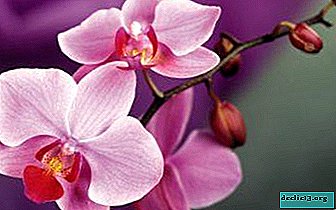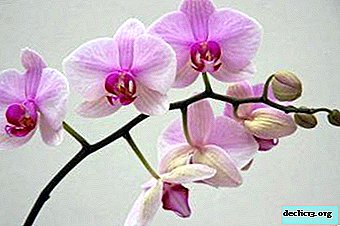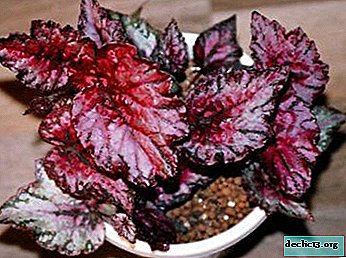We understand why the orchid dries and what to do to save it
 Orchid is a very beautiful and capricious exotic plant, which is difficult enough to keep indoors. When purchasing this tropical flower, you need to read the detailed instructions for growing it to avoid problems when caring for it. In the article, we will consider what to do if the orchids begin to dry the leaves, and also what to do if the flower stalk dries. By what means and methods you can save a “diseased” plant.
Orchid is a very beautiful and capricious exotic plant, which is difficult enough to keep indoors. When purchasing this tropical flower, you need to read the detailed instructions for growing it to avoid problems when caring for it. In the article, we will consider what to do if the orchids begin to dry the leaves, and also what to do if the flower stalk dries. By what means and methods you can save a “diseased” plant.
When can a flower stalk dry in a plant?
Allocate natural and not natural drying. In the first case, the orchid, even with proper care, begins to fade and lose its bright green saturated color about 4-6 years after planting.
Reference. If the peduncle, even after prolonged flowering, remains fresh and green, this can only mean that the plant will begin to bloom again soon.But in most cases, the flower stalk after a long flowering begins to fade and turn yellow until all is dry. Cutting it off or not is the choice of the owner of the flower only, however, remember that the peduncle may not dry out completely and after a while a new branch appears on the side of it.
In most cases, orchid dries prematurely due to improper care of the plant.
- Excessive moisture. Beginners who first encountered orchid cultivation should always be aware of this. That the plant is better not to completely moisten than to fill it with water. From excess moisture, the flower very quickly begins to fade and dry.
 Not enough moisture. Fearing to oversaturate the plant with water, you can not completely leave it without moisture, from this it will also soon die. Moisture for the orchid, although in small quantities, is still very necessary.
Not enough moisture. Fearing to oversaturate the plant with water, you can not completely leave it without moisture, from this it will also soon die. Moisture for the orchid, although in small quantities, is still very necessary.- Burn from direct sunlight. Orchid does not like direct sunlight to fall on it, often this is the reason for the appearance of yellow spots on the leaves.
- Fertilizers You need to fertilize the orchid, but you need to do this only in accordance with the instructions, otherwise the plant can be harmed instead of good.
Why do the stem and leaves dry?
There may be several reasons for the drying of the orchid, but the most basic:
- Overheat. The plant overheats in the event of direct sunlight. Determining overheating is quite simple - the leaves dry and turn yellow, and the roots turn brown and become much thinner than normal.
- Poor watering. Orchid is a plant that not only does not tolerate overflow, but also does not like drying out. With excessive watering, rotting of the root begins, which subsequently leads to the drying of the stem and leaves.
- Fertilizers Many gardeners mistakenly believe that the more carefully the orchid is fertilized, the better, but this is not so. With excessive fertilizer of the soil, the root begins to die, gradually reaching the stem and leaves.
- Pests. This is another common reason for orchid wilting. It is possible to determine that the plant was attacked by pests from the appearance of plaque and small light spots on the leaves.
Read about why the roots dry in the orchid and how to help the plant, read here, and from this article you will learn about the reason for the drying of flowers and what to do to prevent the secondary occurrence of the problem.
What is the danger to the plant?
Despite the fact that the orchid is a very beautiful exotic plant, some of its species and varieties can not be brought home, as this can be fraught with mortal danger. This is due to the fact that some orchid varieties contain poisoncontributing to the development and rapid growth of cancer cells.
Important! If there is a poisonous plant in the house, then the fumes of the poison are not transferred through the air, but are transmitted through direct contact with infected areas and when the poison enters the mucous membrane. Therefore, when treating the soil or during an orchid transplant, gloves should be used.Despite the fact that cases of infection with such a plant as an orchid are extremely rare, at home it is still better to grow a flower designed specifically for such conditions.
Do I need to process with funds?
Orchid is quite resistant to the development of diseases and the appearance of pests, however, problems sometimes still happen.
 One of the most common problems an orchid is exposed to is the appearance of rot on the leaves. This occurs due to excessive soil moisture or frequent spraying. In this case, the plant is not easy to cure, since not only the leaves, but the entire root system are rotted.
One of the most common problems an orchid is exposed to is the appearance of rot on the leaves. This occurs due to excessive soil moisture or frequent spraying. In this case, the plant is not easy to cure, since not only the leaves, but the entire root system are rotted.- If putrefactive sites are found, it is necessary to cut them off with a sharp knife, having previously disinfected it. When cutting, you need to capture part of the healthy section of the flower.
- After the damaged area of the plant is completely removed, the section must be treated with a special bactericidal solution, and then transplanted into another container, completely replacing the soil.
- In addition to mold, orchids can be affected by pests., the most common of them are mealybug and spider mite. If there are few insects, then it is quite possible to get rid of them with a soapy solution. Having prepared the solution from laundry soap and water, they need to wipe each leaf of the plant, the procedure needs to be done 2-3 times, repeat in a week.
If the plant is defeated by the pest infection quite strongly, then it must be treated with such agents as Actar or Fitoverm. These care products are sold only in specialized stores.
What to do and how to revive?
The plant can be reanimated by the following methods:
- Stem. Often the orchid stem begins to turn yellow due to a sharp change in the microclimate, so if you buy a perfectly healthy flower in the store, and after a while the plant starts to fade and turn yellow, then you do not need to worry about it, since with proper care the orchid will come to yourself.
- Flower stalk. This part of the orchid can dry out for completely natural reasons, this usually happens after prolonged flowering. To undertake something in this case or not is the choice of the plant owner. If the peduncle began to dry up during the flowering process, and new flowers began to fade and crumble, then the main reason for this is the lack of light. In this case, the plant needs to be rearranged to a more illuminated place, if there is no such place, then it is necessary to provide the orchid with additional lighting.
- Sheet. There may be several reasons for the orchid to turn yellow and the leaves to dry, so it is important to analyze the situation to understand whether the flower is being taken care of properly or not. If during the inspection of yellowed leaves pests are found on them, it is recommended to treat the plant with the necessary means to protect against them.
Often the leaves begin to dry when exposed to direct sunlight, in this case, it is enough to simply rearrange the plant in a darker place.
On a note. Yellowed leaves located in the lower part indicate excessive watering.In order to bring the plant back to normal, you need to carefully dry the substrate and cut off all dried leaves.
 Root. The main causes of dying off the root system of an orchid are improper watering and low humidity. The plant needs to be sprayed every day, while not only the leaves, but also the roots should be sprayed, however, it is important to ensure that the substrate thoroughly dries between the irrigations, otherwise the root may rot. In order to reanimate a dried orchid, you must first clean the root, and then transplant the plant into a new container, and replace the substrate.
Root. The main causes of dying off the root system of an orchid are improper watering and low humidity. The plant needs to be sprayed every day, while not only the leaves, but also the roots should be sprayed, however, it is important to ensure that the substrate thoroughly dries between the irrigations, otherwise the root may rot. In order to reanimate a dried orchid, you must first clean the root, and then transplant the plant into a new container, and replace the substrate.A weakened root system will not be able to hold the plant on its own for the first time, so it needs to be strengthened additionally. Place an orchid in a well-lit place, but avoid direct sunlight. Until the roots finally get stronger, watering the plant needs to be done very carefully, excellent in this case is the humidification of the substrate from the spray gun. Lower watering also contributes to a quick restoration of the root system of the plant - water is poured in a saucer on which stands a flower pot.
Prevention
Simple preventive measures will help prevent such an exotic plant as an orchid from drying out and diseases:
- Orchid does not like direct sunlight, so you need to place it not on the south, but on the east or west sides.
- For a comfortable habitat of an orchid, it must be lit at least 12-13 hours a day. In summer, normal daylight is sufficient, and in winter, additional lighting using special lamps is required.
- The room in which the orchid is located must be regularly ventilated, so that the soil is saturated with oxygen and the roots are ventilated.
- The plant must be sprayed with water, especially on hot days or with the batteries turned on. Humidity, in which the flower feels as comfortable as possible, should reach 40-50%.
- Watering should be carried out only as the roots dry - if they are bright green, then the orchid does not need watering, and, conversely, if the roots begin to wrinkle and have a dull shade, then the plant needs to be watered.
Useful video
The phalaenopsis orchid dries and turns yellow. Watch the video on why this happens and how to reanimate it:
Conclusion
So, we examined how to revive a dried plant, what to do if the stems, flower stalks have dried. From all of the above it follows that caring for an orchid is a hard and painstaking work, but it's worth it. After all, with proper care, this tropical plant will certainly thank the owners with its regular flowering and beauty.

 Not enough moisture. Fearing to oversaturate the plant with water, you can not completely leave it without moisture, from this it will also soon die. Moisture for the orchid, although in small quantities, is still very necessary.
Not enough moisture. Fearing to oversaturate the plant with water, you can not completely leave it without moisture, from this it will also soon die. Moisture for the orchid, although in small quantities, is still very necessary. One of the most common problems an orchid is exposed to is the appearance of rot on the leaves. This occurs due to excessive soil moisture or frequent spraying. In this case, the plant is not easy to cure, since not only the leaves, but the entire root system are rotted.
One of the most common problems an orchid is exposed to is the appearance of rot on the leaves. This occurs due to excessive soil moisture or frequent spraying. In this case, the plant is not easy to cure, since not only the leaves, but the entire root system are rotted. Root. The main causes of dying off the root system of an orchid are improper watering and low humidity. The plant needs to be sprayed every day, while not only the leaves, but also the roots should be sprayed, however, it is important to ensure that the substrate thoroughly dries between the irrigations, otherwise the root may rot. In order to reanimate a dried orchid, you must first clean the root, and then transplant the plant into a new container, and replace the substrate.
Root. The main causes of dying off the root system of an orchid are improper watering and low humidity. The plant needs to be sprayed every day, while not only the leaves, but also the roots should be sprayed, however, it is important to ensure that the substrate thoroughly dries between the irrigations, otherwise the root may rot. In order to reanimate a dried orchid, you must first clean the root, and then transplant the plant into a new container, and replace the substrate.















